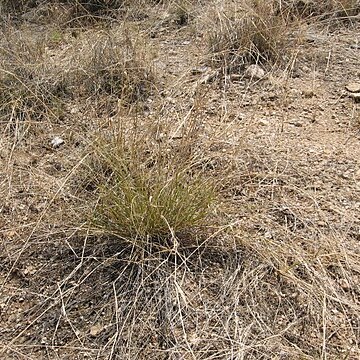Tufted erect perennial, up to 600 mm high; geniculate, sometimes rooting at lower nodes; basal sheaths papery, nerves round, not close together or forming prominent ridges, glabrous or slightly hairy. Leaf blade up to 250 x 1.5-2.8 mm; ligule a fringe of hairs. Inflorescence an open, lax panicle, branches 1 or 2 at base, not whorled. Spikelets 4-8 x 1.0-1.5 mm, linear to oblong, laterally compressed, dark green, grey-green to red with yellow; rachilla subpersistent, fragile in upper portion; glumes shorter than spikelet, 1-nerved. Florets many; lemma entire, 3-nerved; palea margins wide apart, keels thin, narrow, glabrous or scaberulous; anthers 3, 1.0 mm long. Flowering time Nov.-June. Caryopsis oblong.
Caespitose perennial without rhizomes but sometimes with stolons; culms up to 90 cm tall, erect, ascending or decumbent and rooting at the nodes, branched, glabrous at the nodes (but the internodes glabrous or pilose), eglandular; basal leaf sheaths shortly pilose below or sometimes glabrous, chartaceous, ± compressed and keeled, eglandular, persistent; ligule a line of hairs; leaf laminas 6–25 cm × 1.5–3.5 mm, linear to broadly linear, flat, puberulous above, eglandular.
Panicle 9–16 cm long, ovate to narrowly ovate-elliptic, loose and open, the spikelets condensed about the branchlets on pedicels 0.5–1 mm long, the primary branches not in whorls, terminating in a fertile spikelet, glabrous in the axils, eglandular.
Is another South African species introduced to East Africa as a forage grass.. It differs from E. curvula in its wiry culms and papery unridged leaf-sheaths silky pubescent at the very base.
Caryopsis 0.7–0.8 mm long, oblong to elliptic.

